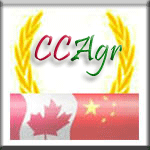Directory:Canada-China Agriculture and Food Development Exchange Center
| Canada-China Agriculture and Food Development Exchange Center | |
 | |
| Slogan | Connecting Canadian and Chinese Agri-Businesses |
|---|---|
| Type | [[Company_Type:=Private|Private]] |
| Founded | [[Year_Started:=2008|2008]] |
| Headquarters | [[City:=Hamilton|Hamilton]], [[State_Name:=Ontario|Ontario]], [[Country_Name:=Canada|Canada]] |
| Industry | [[NAICS_Code1_Title:=Consulting|Consulting]] [[NAICS_Code2_Title:=Connecting Canadian agricultural endeavors with Chinese partners looking to invest|Bridging Businesses]] |
| Contact | 1300 Garth Str. Hamilton, ON L9C 5V0-0000 905.769.4756 [http://www.ccagr.com/content/view/19/81/ CCAgr website] |
| Reference | Hu, Dinghuan (2004). "The Emergence of Supermarkets with Chinese Characteristics: Challenges and Opportunities for China’s Agricultural Development". Development Policy Review 30: 557-586 |
Canada-China Agriculture and Food Development Exchange Center or CCAgr (Chinese: 加拿大-中国农业与食品发展交流中心) is an organization based out of Hamilton, Ontario. CCAgr was created in 2008 to help connect Canadian and Chinese agricultural businesses through addressing cultural and language differences and contend with technical skill and regulatory system limitations. The organization is comprised of a Canadian government sponsored management advisory team and Canada–China agri-food experts.
Background
China has been described as an emerging economic super power[1] and the growing purchasing power of its continually expanding middle class is a well documented feature of the countries economy[2]. These facts have made the Chinese market place for high quality and added value agricultural products a growing area of interest and an area that many economist have described as a missed boat for developed countries like Canada[3]. China has not been able to facilitate the growth and advancement of the agriculture sector fast enough to ensure that consistently high quality food products are available for the ever increasing middle class[4]. Furthermore, scandals such as the melamine tainted milk products, that resulted in the death of several infants, has served to increased the size of the market for food products produce in developed countries with high safety and quality control standards[5]. This market is a blooming one and persons involved in agricultural endeavors would do well to investigate the areas available for growth.
References
- ^ <templatestyles src="Module:Citation/CS1/styles.css"></templatestyles>James F. Hoge, Jr. (2004-07). "A Global Power Shift in the Making". Council on Foreign Relations. Retrieved 2009-03-03. Check date values in:
|date=(help) - ^ <templatestyles src="Module:Citation/CS1/styles.css"></templatestyles>Yann Layma (2006). "The value of China's emerging middle class" (PDF). McKinsey&Company. Retrieved 2009-03-02.
- ^ <templatestyles src="Module:Citation/CS1/styles.css"></templatestyles>David Mavin (2009-02-21). "Canada missing the boat in trade with China". Financial Post. Retrieved 2009-03-02.
- ^ <templatestyles src="Module:Citation/CS1/styles.css"></templatestyles>Frank Fuller, Francis Tuan and Eric Wailes. "Rising Demand for Meat: Who Will Feed China's Hogs?" (PDF). Economic Research Service and the USDA. Retrieved 2009-03-02.
- ^ <templatestyles src="Module:Citation/CS1/styles.css"></templatestyles>The CattleSite News Desk (2009-02-12). "Mirror on Melamine as China's Dairy Exports Drop". TheDairySite. Retrieved 2009-03-02.
Photo gallery
External links
<sharethis />
Geolocation
{{Mapit-US-cityscale|35.019608|-90.0

